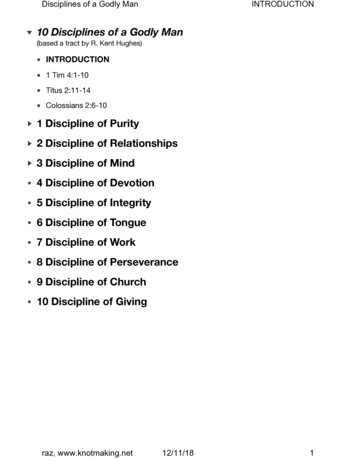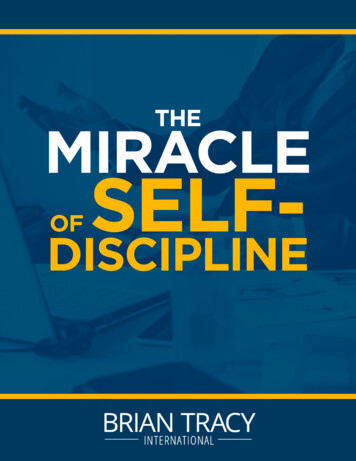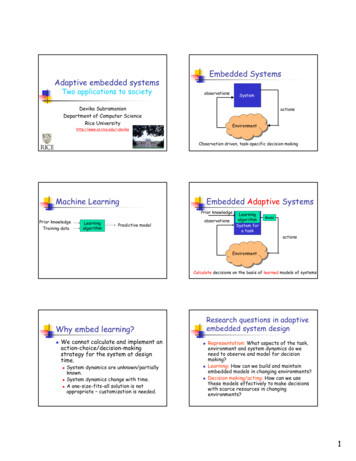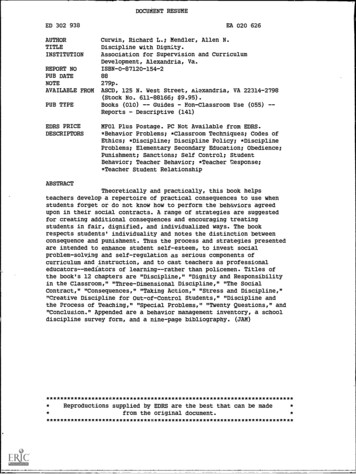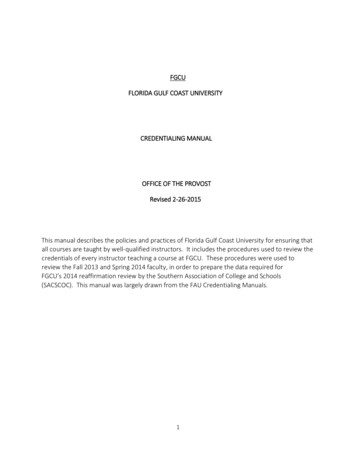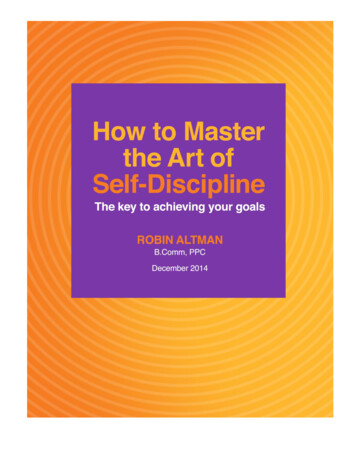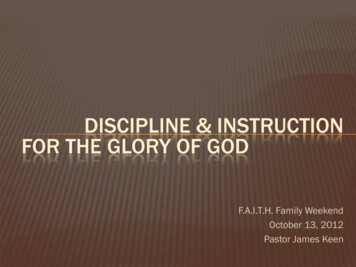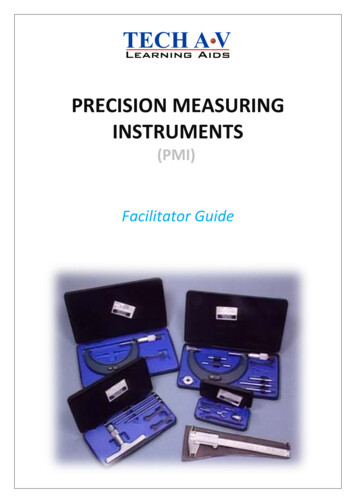
Transcription
Education Management & Development Centre: Metropole NorthLearnerDisciplineandSchoolManagementA practical guide tounderstanding and managinglearner behaviour withinthe school context 2007
ContentsPoint of departureClassroom managementThe development and management of aculture of positive behaviour in the schoolClassroom code of conductThe rights of the educatorTeaching of large classesPositive discipline: role of parentsHandling behaviour problemsThe school’s code of conduct for learnersAnger managementThe disciplinary hearingHandling conflictSupport structuresBullyingThe educator as professional personBibliographyHandling of stress by the educatorLearner Discipline and School Management1
Message from the Director:EMDC Metropole NorthLearner behaviour problems have, for years, been a majorconcern for teachers, administrators and parents. More thanever before, teachers are faced with critical problems intheir classrooms, and are confronted (on a daily basis) withunacceptable learner behaviour and threatening situations.After the abolishment of the old system of corporal punishmentand control, an urgent need arose to deal with behaviouralissues in innovative ways.The new approach to positive behavioural support represents ashift from a focus on deficit and control, towards a developmentaland restorative approach. This will enable learners to progresstowards responsibility, relationship building and a greatersense of well-being. This approach is also embodied in theSouth African Constitution, the South African Schools Act andthe specific outcomes of the National Curriculum Statementwhich give priority to the concept of responsibility.For the past 5 years, the EMDC Metropole North has beeninvolved in an intensive training programme for educators witha view to improving the management of discipline and skill inthe handling of learner behaviour. The theme “Understandingand Managing Learner Behaviour” focuses on the shift fromthe control and punishment of learners to positive behavioursupport. It furthermore advocates a shift from behaviourmanagement to relationship building and the promoting of arestorative approach towards challenging behaviour.Learner Discipline and School ManagementThis approach is essential for the holistic development of thechild. It is important that this approach be supported by clearguidelines for actions, which is why this document has beendeveloped, namely, to create basic guidelines so that everyschool can develop and maintain a discipline structure. Thefocus falls particularly on the creation of a code of conductfor learners and the implementation thereof, from the schoolmanagement team to the classroom. The document allowsroom for further development by the school itself and for theaddition of other important information.This document was drawn up after thorough research andtakes into consideration legal aspects and the latest educationregulations. I would like to encourage principals to implementthe principles and guidelines in this document, because themanagement of healthy, positive discipline remains the dutyand responsibility of the school and its partners. The EMDC willgladly provide further support.I wish to thank Neville Goliath, Bridget Goosen, JohanPretorius, Sura Swart and Koos Theron for their sterling workand contribution towards better education.B Volschenk2
Point of Departure Understanding and managing learner behaviour hasbecome a challenge for schools in South Africa. Positive discipline has as its goal the whole development ofthe child. Engaging with learners and considering their needsrequires effective systems, skills and a positive attitude. The management structures in schools should give clearguidelines on the management of learner behaviour. The educator has an important responsibility to facilitate aclimate for the development of positive learner behaviour. The role of the parent, as primary educator and partner inthe shaping of the learner’s character is indispensable. Schools must create the space and offer the opportunityfor learners to develop leadership. The code of conduct for learners serves as the basis for thedevelopment and promotion of positive learner behaviour. Practical skills are needed in times of crisis, when learnersare experiencing emotional stress.Learner Discipline and School Management3
The development andmanagement of a Culture ofPositive Behaviour in the school1. The basis for positive behaviourAn important shift of focus in the effective management oflearner behaviour is the development and management ofpositive relationships, between children and between childrenand adults. A climate of trust and understanding of each other isessential as a basis for the building of relationships and it mustbe developed and implemented by the whole school and class.If this is the case, mutual respect, caring, knowledge of eachother’s feelings, an “I belong”-feeling and the willingness totake responsibility for own actions and deeds can be achievedmore easily.Schools have an important task to teach children to differentiatebetween acceptable and unacceptable behaviour. Opportunitymust also be given for the development of insight and learning.In a positive school situation a breaking of school rules istherefore viewed as not only a negative action towards theschool, but also a negative action towards fellow learnersand teachers and the disruption of mutual relationships. In apositive school climate, school rules are instrumental to thewhole development of the learner.Learner Discipline and School ManagementThe strategy for positive behaviour leans heavily on theprinciples of the “Circle of Courage” model, which are basicallythe following: “I belong” “I am achieving” “I am independent” “I am generous”This developmental approach focuses on allowing childrenthe opportunity to grow in themselves. Through this, theyexperience themselves positively and they make good decisionsso that they can progress to independence.
Learner Discipline and School ManagementBehaviour Management within the “Circle of Courage”SchoolMap o si tiv e b e hfoavireuoutlurCnaadeyHutpDegerSchool GoverningBody & ParentsRepresentativeCouncil of LearnersPrefect programme& Class monitorstHdeanmeDertapEducCodeoaf Conduct for Lersernator
2. The co-ordinated and integratedmanagement of positive learner behaviour2.1 Duties and responsibilities of the SchoolManagement TeamWhole school development with a focus on a culture of positivebehaviour must be well managed, as it involves an attitudeand work ethic that are driven by good professionalbehaviour, support structures and good planning. Realisinga permanent belief in the system requires active leadership.The important role players are the school management team,educators, learners, representative council of learners, classmonitors or prefects and the school governing body (SGB). Themanagement of a culture of positive behaviour is a co-ordinatedand integrated approach with a clear task for each role playerto ensure positive behaviour. The “Circle of Courage” model isthe basis for implementation.The management of a culture of positive behaviour requiresactive leadership to realise a constant flow of positivepredisposition towards and belief in the system. It thereforeinvolves firm, co-ordinated and planned actions in theimplementation of the general code of conduct for learnersand school ethic.Learner Discipline and School Management
Learner Discipline and School Management The School Manager- Primarily responsible for establishing the concept ofpositive behaviour within the school set-up.- Ensure that all personnel, parents and learners are aware ofthe policies regarding positive learner behaviour.- Ensure that policy regarding disciplinary measures isimplemented.- Ensure that learner behaviour and learner issues arediscussed regularly.- Ensure that record is kept of learner behaviour.- Organise staff development sessions regarding themanagement of learners’ behaviour.- Organise interviews with parents about the progress andbehaviour of learners.- Ensure that the school has a good orientation programmefor new learners (especially Grade 8).- Ensure that learners are dealt with fairly and consistently. The Deputy Head- Responsible for the application of discipline.- Support the principal in the performance of duties tocreate a school culture of positive discipline.- Support the principal in the provision of learner supportand guidance regarding good discipline.- Supervise the representative council of learners.- Responsible for the supervision and mentoring of a prefectprogramme. The Department Head- Responsible for regular formal meetings with grade heads,senior educators, phase leaders, etc.- Conduct discussions about disciplinary tendencies andconcerns in the school.- Provide feedback regarding EST recommendations andinterventions.- Liaison with multifunctional teams from district centres,community organisations and NGOs. Grade Head/Senior Educators- Organise regular scheduled meetings with grade, learningarea and/or phase educators.- Hold discussions to identify possible referrals to the EST.- Organise interviews with parents to discuss learnerbehaviour and needs.- Control and manage the administrative system ofdisciplinary referrals and interventions.- Report to the SMT on disciplinary tendencies and concerns.
2.2 Duties and responsibilities of the Educator Create a learner-centred classroom where discussion isallowed between learners, but the discussion takes place ina focussed and orderly manner. Prepare well so that lessons can run smoothly anddiscipline can be applied more easily. Expect co-operation of learners. When instructed to “takeout books”, the instruction must be followed. Wait until ithappens! Do not make threats that cannot be carried out. Do not just criticise. When commenting on the learner’swork, remember to praise the learner also. “Punish” only in accordance with the school’s code ofconduct for learners and the classroom code of conduct. Make sure that the offender is taken to task. The wholeclass must not be punished. This is unfair and may nothappen. Do not allow a queue to form when you are correctingbooks. Time is wasted and there is a strong possibility thatdiscipline problems will develop. Do not sit when you are teaching. Move around andobserve learners while they are busy with group activities. Approach the EST for advice and support regardinginterventions and how to handle specific learner needs. The school management team is there to support you.Rather get help than allow disciplinary problems todevelop.Learner Discipline and School Management2.3 Duties and responsibilities of the SchoolGoverning Body Responsible for the development and regular revisionof the code of conduct for learners in co-operation withparents, educators and learners. Responsible for the creation of a disciplined and goalorientated environment to ensure teaching and learning. Ensure that the disciplinary practices of the schooltake place within the framework of the South AfricanConstitution and the South African Schools Act. Appoint a disciplinary committee. Conduct fair hearings in which the focus is on positiveintervention as a restorative option. Keep full minutes of disciplinary hearings. Hold regular meetings with parents to discuss disciplinarymatters.
Learner Discipline and School Management2.4 Duties and responsibilities of the RepresentativeCouncil of Learners (RCL) Develop and promote a positive learner spirit and culturewithin the school. Encourage fellow learners to participate and areresponsible for the sound functioning of the school. Promote good discipline by holding regular learnermeetings and discussions. Use communication channels to discuss learner frustrationsand fears. Promote positive communication with educators andschool management. Create clubs and special projects to promote learnerinvolvement. Take part in school governing body activities. Act as ambassadors in the school and community.2.5 Duties and responsibilities of the PrefectProgramme/Class Monitor System Promote good discipline in class and on the schoolpremises. Ensure a clean and tidy classroom. Promote classroom pride. Monitor class attendance. Liaise with class educators about learner issues and learnergrievances.
The Rights of the Educator As with every citizen of the country, educators have certainrights protected by the Constitution. The fundamental rights ofeducators are further protected by the tenets of common lawand national legislation.Educators are entitled to the following:- Equality.- Human dignity.- Privacy: to live your life with the minimum of interference.This includes private, family and home life; physical andmoral integrity; honour and reputation. An educator’sright to privacy means that he or she also has the rightnot to be portrayed in a poor light or subjected toembarrassment, and has the right to confidentiality. Owingto the educator’s public status, there is, however, a limitto the educator’s right to privacy w.r.t. family life, sexualorientation and information about his or her state of health.- Freedom of religion and opinion.- Freedom of expression: Educators’ freedom of expressioncan, however, be limited insofar as it threatens the otherperson’s rights, or in the interest of education.- Freedom of association.- Political rights.- Labour rights.- Language and culture.- Protection of and respect for the dignity of the educator.Bear in mind that this cannot be enforced, but is earnedthrough personal conduct.Learner Discipline and School Management The rights of the educator must, however, always be weighedagainst that which is in the interest of the maintaining of aneffective, collaborative teaching and learning environment.Learner behaviour which is in conflict with the rights of theeducator must always be evaluated against the background ofthe characteristics typical of a child, i.e.:- Absence of discernment.- Absence of rational thought.- Emotional immaturity.- Impulsive behaviour.
Positive Discipline:Role of Parents1. The primary school learner Know the school’s code of conduct and encourage yourchild to uphold it. Strengthen the code of conduct by taking primaryresponsibility for your child’s discipline. Create a safe atmosphere for your child so that he/she cangrow and develop positively. Ensure your child’s regular and punctual attendance atschool. Communicate reasons for your child’s absence tothe school. Communicate regularly with your child about his/herschoolday. Children always have the need to share whathappened at school. Get to know your child’s teacher. A good parent-teacherrelationship ensures a happier child with a strong sense ofsecurity. This is an advantage when manipulative behaviourneeds support and correcting. Reinforce learning at home by going over your child’shomework. Be involved by supporting his/her academic and extramural activities. Listen with an open mind to your child and the educator.Guard against being prejudiced and always look for a winwin solution. Teach children to find positive solutions to problems thatthey encounter daily and to manage confrontation withoutviolence.Learner Discipline and School Management2. The high school learner Know the school’s code of conduct and encourage yourchild to uphold it. Strengthen the code of conduct by taking primaryresponsibility for your child’s discipline. Create a safe atmosphere for your child so that he/she cangrow and develop positively. Be involved in your child’s life. Be aware of what is goingon in his/her life. Be informed about the development ofteenagers to ensure that you understand the behaviourbetter. Create quality time for your child. Adolescence is a timeduring which the teenager disengages him/herself fromfamily and spends more time with friends and at school.Time with family and parents is however vitally importantfor the emotional and social development of your child. Listen rather than talk. Adolescents want to beacknowledged and give expression to their feelings.Acknowledge this, listen with understanding and act as aguide. Positive reinforcement for positive behaviour! Reinforcepositive behaviour – it is more effective than criticism.Disparaging remarks harm the adolescent’s feelingsand self-esteem. The best instruments available toyou for building meaningful relationships are love,caring, sensitivity, encouragement, understanding andcommunication, attention, appreciation and acceptance.
Learner Discipline and School Management Teach your adolescent that rights and responsibility gotogether. Give them increasing rights and make them partof decision-making conversations. Develop their ability tomake choices, solve problems and make decisions. Encourage them to get involved in community activities.The adolescent’s sense of self-worth is developed throughinvolvement in community initiatives. It shifts the focusfrom “me, myself” and develops fellow feeling. Build memories with your child. Be aware that your feelings have an effect on yourchild. The way in which you handle it will develop anunderstanding of others’ emotions in your child. Stay up-to-date on your adolescent’s world by havingregular discussions with other parents and/or professionalpersons. Know the danger signs for the “child in crisis” andact in time.Sources available:Department of Social Services021 9487100Bellville021 4819700Cape Town021 4617360Cape Town021 5922063GoodwoodParent Centre021 7620116WynbergBadisa021 9326721Elsies RiverPlanned Parenthood Assoc. of SA021 4487312Cape TownFAMSA
The School’s Code of Conductfor LearnersThis is not a set of rules and measures for punishment, but is theschool’s framework for the creation of a culture of positivebehaviour within which learners should conduct themselves.The code of conduct must be compiled in co-operation with allthe relevant persons (teachers, learners and parents) and mustbe revised regularly. A school must reach consensus on a uniform disciplinarystructure that is, in spirit and practice, firm, fair, consistentand positive. A code of conduct gives expression to the norms andvalues that are prescriptive for and applicable to learners’behaviour, actions and functioning within that specificschool. A code of conduct (as prescribed by Section 8 (2) of theSouth African Schools Act) must be aimed at:establishing a disciplined (learners have characteristicssuch as self-control, responsibility, obedience,excellence) and purposeful school environment (allactivities within the school environment are inaccord with the vision of the school), dedicated tothe improvement and maintenance of the quality of thelearning process.Learner Discipline and School Management1. Objectives of a code of conduct To create a culture of teaching and learning within a schoolthrough a discipline system that protects all the learners’right to effective education, their right to human dignityand their right to security. To give a clear, defined explanation of the behaviour andactions expected of learners so that they can adapt theirbehaviour accordingly. To spell out the consistent and uniform actions in theevent of infringements and thereby create a feeling ofsecurity amongst the learners, in that it is clear to all whatis expected from them. To serve as a gauge for fair and reasonable actions. To guide the daily functioning of the school and allowactivities to happen in an orderly manner. To realise a safe environment for learners and educators. To support the objectives, as formulated in the school’smission statement.
Learner Discipline and School Management2. Requirements for a code of conductA school’s code of conduct provides educators with the degreeof authority that they need to allow teaching and education totake place in an orderly way. It is therefore very important thatattention be given to the requirements set for a valid code ofconduct. The following applies for a school’s code ofconduct:- It is subject to existing legislation. The South AfricanSchools Act prescribes how a code of conduct must bedrawn up and the Constitution serves as a basis for thecontent of the code of conduct.- It must be drawn up against the background of the school’sethics and take into consideration the particular characterof the school and the values and culture of the learners andthe community.- It must promote positive discipline and development andnot be focussed on punishment.- It must include a description of the type of behaviour thatis not acceptable (and in some instances is acceptable) andmust indicate what the school’s reaction to such behaviourwill be.- It must be aimed at creating a disciplined and goalorientated school environment within which qualityeducation can take place.- It must be set out clearly and unambiguously.- It must be accessible and user-friendly.- It must meet the requirements of being fair andreasonable.- It must set a standard of ethically correct behaviour.- It must be dynamic and flexible.- It must give learners the right to and the responsibility for being informed about the behaviour that is expected ofthem. being informed about the consequences of theirbehaviour.3. Process for the establishment of a code ofconduct Section 8 of the South African Schools Act stipulates thatall schools must draw up a code of conduct. Althoughthe principal and educators are responsible for the dailydiscipline in the school, the governing body has a duty toensure that the school adopts a code of conduct. The establishment of a code of conduct involves theparticipation of all role players, namely parents, educatorsand learners, in the process. This process must be openand democratic in nature and give opportunity forconsultation and negotiation. Through this it is ensuredthat the whole school community accepts ownershipfor the code of conduct and the application thereof. Itis especially important that all learners are aware of thecontent of the code of conduct. Although every school draws up its own code of conduct,appropriate to the relevant circumstances, the code ofconduct must comply with the requirements mentionedabove.
4. Scope of a code of conduct No learner is exempt from the duty of complying with thecode of conduct. It is, however, important that the whole school communitybe aware of where and when the school’s code of conductis applicable, namely:- On school premises before, during and after schoolhours.- During all school activities – on or off of school property.- Outside the school property when the learner isidentifiable because of school clothes.5. Structural Framework for a Supportive andRestorative Code of ConductA school’s code of conduct should be compiled according tothe following framework: An introduction containing the principles, philosophy andethos found in the SA Schools Act. Values such as respect,tolerance and reconciliation must be set as guidelines.It must be stated clearly that education is not only theresponsibility of the government, but also of learners,educators and parents. References to the legislation on which the code of conductis based. A mission and vision, in which the values which form thefoundation for all decision-making concerning learnersare spelt out clearly. It is, moreover, important that themission, vision and values be shared by the whole schoolcommunity.Learner Discipline and School Management Values and general principles that ought to be applicableare:- respect for fundamental human rights.- respect for educators.- acceptance of multiculturalism and diversity.- respect for the environment and school facilities. General school rules that comply with the requirementsof being clear, fair, reasonable and which can be enforced.These can comprise- a description of the positive behaviour that is expectedfrom learners.- a description of the types of behaviour that areregarded as being unacceptable. The rules must be formulated in such a way that they coverall aspects of school life: academic, cultural, sport, humanrights, authority of the school, behaviour within and out ofthe school, as well as the physical facilities and grounds. School rules must have educational goals. They must be necessary, relevant and applicable. They must include a description of the circumstances underwhich the code of conduct will be applicable, as well as thedisciplinary procedures and forms of punishment.6. Learner Infringements with reference toSupport Mechanisms(The following serve as suggestions for supportive andrestorative mechanisms and should be implemented togetherwith restorative measures appropriate for each level.)
Learner Discipline and School ManagementLevel 1Learner infringementsResponse and Support Copying of homework. Class educator/Learning area educator responsible forclassroom management of learner behaviour (see Late arrival for class, lines, during assemblies, meetings,etc. Talking in class, lines, assemblies, during announcements,etc. Not following reasonable instructions, e.g. does not workin class.Classroom Management ). Classroom rules: a prerequisite for the management of behaviourand the application of measures (see Classroom Code of Conduct). Schoolbooks are neglected. General untidiness. Vandalism (including littering). Misuse and unauthorised use of school equipment (fireextinguishers, taps, alarm system, etc.) Leaving school/classroom without permission. Use of humiliating and suggestive language and signs. Disrespectful actions towards educators. Deliberate disruption of class. Eating in class, playing withcell phone, etc. Absence without leave/Truancy. Flouting of class rules. Inciting fighting, bullying behaviour (needling). Misconduct on busses to and from school Peer help programmes can have a positive influence on thecreation of a positive school climate and the management oflearner behaviour (see Support Structures ).
Level 2Learner infringementsResponse and Support Repeated Level 1 infringements. EST: the school-based team and senior management team, withuse of relevant advisers in the community and the EMDC’s circuitteam (see Support Structures ). Disruption of class (repeated). Racist, sexist and discriminatory comments and behaviour. Possession and distribution of pornographic, racist, sexistmaterial; or viewing of and/or downloading of such on anycomputer or cell phone at school. Fraud (falsification of documents, cheating in examinations,etc.) Grade Head (see duties and responsibilities of grade head). Parent involvement (involve parents in joint decision makingabout support to learner). Vandalism: graffiti, writing on desks, breaking of windows,etc. Development programmes for communities (get learnerinvolved in appropriate development programme, as offered bycommunity source). Fighting and causing injuries. Corrective measures (decision making by disciplinary committee). Gambling. Smoking cigarettes and possession of cigarettes. Falsification of document with less serious consequences. Individual education support plan (IEDP): keeping of a classreport can form part of this (see Support Structures ). Serious disruption of class. Refusal to submit to corrective measures.Learner Discipline and School Management Educator as mentor for learners (see duties and responsibilities ofeducator).
Learner Discipline and School ManagementLevel 3Learner infringementsResponse and Support Repeated Level 2 infringements. Community service (corrective measures). Repeated serious misconduct. EST: the school-based team and senior management team andalso relevant advisers in the community and the EMDC’s multifunctional team (see Support Structures ). Under the influence of alcohol and drugs. Theft of a serious nature/Burglary. Arson. Serious vandalism. Parent involvement (involve parents in intervention process,(see Disciplinary Hearing ). Sexual abuse (harassment of peer learners). IEDP (see Support Structures ). Sexual misconduct (such as flashing). Development-orientated programmes (get learner involvedin appropriate development programme, as offered bycommunity source). Physical assault of peer learners (fighting, throwing of objects,etc.) Sexual misconduct in which learners are the perpetrators. Threatening of peer learners or educators. Involvement in gang-related activities. Educator as mentor for learners (see duties and responsibilitiesof educator). Circuit team (EMDC) (see Support Structures ). Disruption of school programme through rebellion anddemonstrating without permission. Abuse no more Policy. Trespassing on school grounds while suspension is still ineffect. Departmental policy relating to suspension and expulsion. Making bomb threats. Drug Policy for schools for drug-related misdemeanours. School Governing Body (see Disciplinary Hearing ).
Level 4Learner infringementsResponse and Support Repeated Level 3 infringements. School Governing Body (see Disciplinary Hearing ). Refusal to attend development-orientated programmes. Dangerous weapons: bringing weapons onto school grounds,threatening people with weapon, deliberate assault of personswith weapon. Possession of drugs on school grounds. Dealing in drugs on school grounds. South African Police Service (SAPS) – criminal offences, such asdrugs, weapons, rape, serious assault. Parent involvement (see Disciplinary Hearing andAdvice for Parents ). Serious assault. Social work service providers (Support services to learner andparents). Learner is found guilty in crime court (immediate expulsion). Circuit Team (EMDC) – (see Support Structures ). Sexual assault (rape). Expulsion committee (see Disciplinary Hearing ).Learner Discipline and School Management
The Disciplinary Hearing1. Prescribed procedureThe disciplinary hearing takes place according to a pres
Anger management Handling conflict Bullying Bibliography 1. Learner Discipline and School Management Message from the Director: EMDC Metropole North Learner behaviour problems have, for years, been a major concern for teachers, administrators and parents. More than
